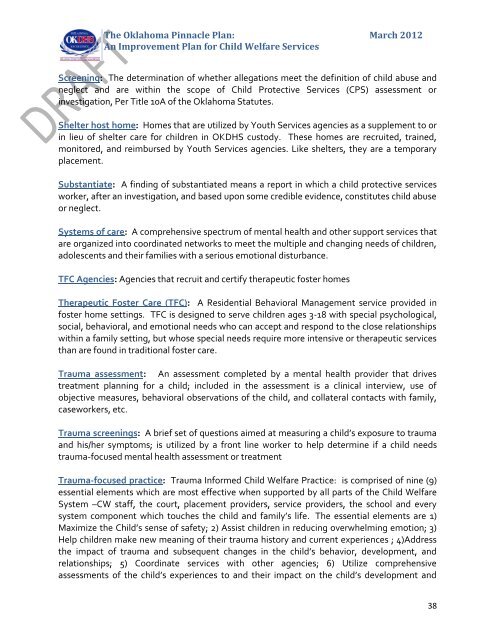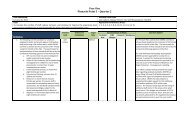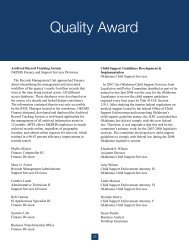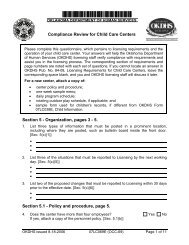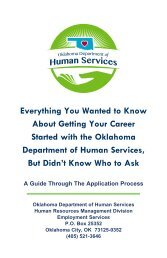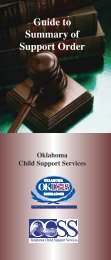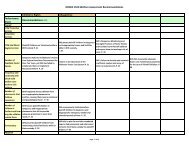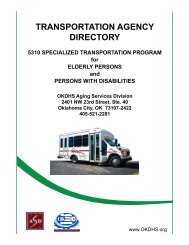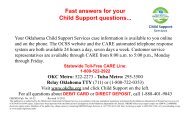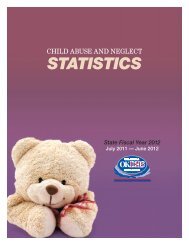The Oklahoma Pinnacle Plan - Oklahoma Department of Human ...
The Oklahoma Pinnacle Plan - Oklahoma Department of Human ...
The Oklahoma Pinnacle Plan - Oklahoma Department of Human ...
You also want an ePaper? Increase the reach of your titles
YUMPU automatically turns print PDFs into web optimized ePapers that Google loves.
<strong>The</strong> <strong>Oklahoma</strong> <strong>Pinnacle</strong> <strong>Plan</strong>:<br />
An Improvement <strong>Plan</strong> for Child Welfare Services<br />
March 2012<br />
Screening: <strong>The</strong> determination <strong>of</strong> whether allegations meet the definition <strong>of</strong> child abuse and<br />
neglect and are within the scope <strong>of</strong> Child Protective Services (CPS) assessment or<br />
investigation, Per Title 10A <strong>of</strong> the <strong>Oklahoma</strong> Statutes.<br />
Shelter host home: Homes that are utilized by Youth Services agencies as a supplement to or<br />
in lieu <strong>of</strong> shelter care for children in OKDHS custody. <strong>The</strong>se homes are recruited, trained,<br />
monitored, and reimbursed by Youth Services agencies. Like shelters, they are a temporary<br />
placement.<br />
Substantiate: A finding <strong>of</strong> substantiated means a report in which a child protective services<br />
worker, after an investigation, and based upon some credible evidence, constitutes child abuse<br />
or neglect.<br />
Systems <strong>of</strong> care: A comprehensive spectrum <strong>of</strong> mental health and other support services that<br />
are organized into coordinated networks to meet the multiple and changing needs <strong>of</strong> children,<br />
adolescents and their families with a serious emotional disturbance.<br />
TFC Agencies: Agencies that recruit and certify therapeutic foster homes<br />
<strong>The</strong>rapeutic Foster Care (TFC): A Residential Behavioral Management service provided in<br />
foster home settings. TFC is designed to serve children ages 3-18 with special psychological,<br />
social, behavioral, and emotional needs who can accept and respond to the close relationships<br />
within a family setting, but whose special needs require more intensive or therapeutic services<br />
than are found in traditional foster care.<br />
Trauma assessment: An assessment completed by a mental health provider that drives<br />
treatment planning for a child; included in the assessment is a clinical interview, use <strong>of</strong><br />
objective measures, behavioral observations <strong>of</strong> the child, and collateral contacts with family,<br />
caseworkers, etc.<br />
Trauma screenings: A brief set <strong>of</strong> questions aimed at measuring a child’s exposure to trauma<br />
and his/her symptoms; is utilized by a front line worker to help determine if a child needs<br />
trauma-focused mental health assessment or treatment<br />
Trauma-focused practice: Trauma Informed Child Welfare Practice: is comprised <strong>of</strong> nine (9)<br />
essential elements which are most effective when supported by all parts <strong>of</strong> the Child Welfare<br />
System –CW staff, the court, placement providers, service providers, the school and every<br />
system component which touches the child and family’s life. <strong>The</strong> essential elements are 1)<br />
Maximize the Child’s sense <strong>of</strong> safety; 2) Assist children in reducing overwhelming emotion; 3)<br />
Help children make new meaning <strong>of</strong> their trauma history and current experiences ; 4)Address<br />
the impact <strong>of</strong> trauma and subsequent changes in the child’s behavior, development, and<br />
relationships; 5) Coordinate services with other agencies; 6) Utilize comprehensive<br />
assessments <strong>of</strong> the child’s experiences to and their impact on the child’s development and<br />
38


